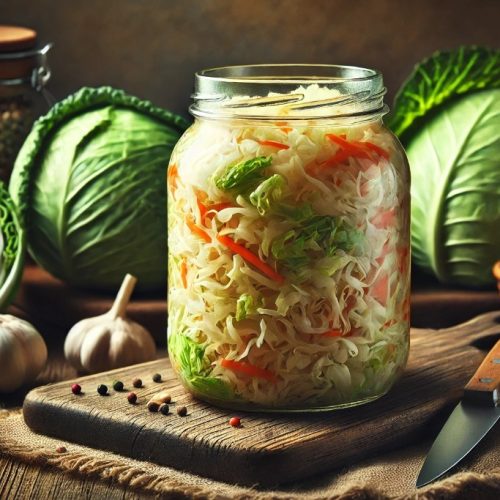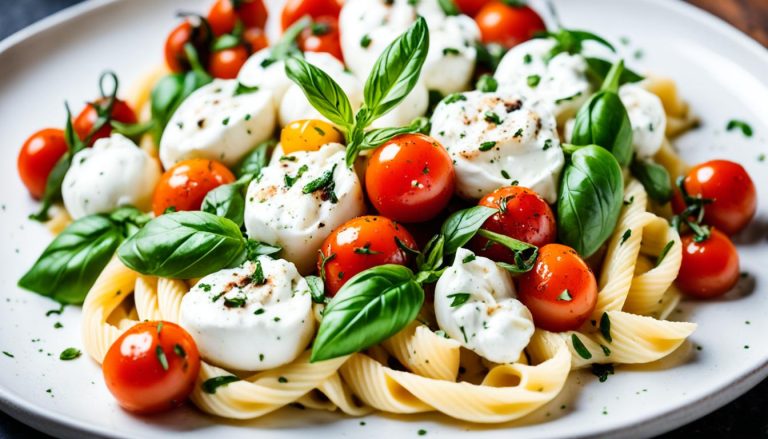Sauerkraut, a fermented cabbage dish, has long been cherished for its tangy flavor and impressive health benefits. Whether you’re new to fermentation or an experienced cook, making sauerkraut at home is simple and satisfying.
Packed with probiotics, vitamins, and fiber, sauerkraut is not only delicious but also great for gut health. Here’s an easy and versatile sauerkraut recipe that you can customize to your taste.
What is Sauerkraut?
Sauerkraut is a traditional fermented food made from finely shredded cabbage that is salted and left to ferment through natural lactic acid bacteria. Originating from Central and Eastern Europe, it has been a staple in German cuisine for centuries.
The fermentation process gives sauerkraut its distinctive sour taste and extends its shelf life, making it a valuable preservation method before refrigeration was common.
Rich in probiotics, fibre, and vitamin C, sauerkraut not only adds a tangy flavour and crunchy texture to dishes but also offers several digestive and immune-boosting health benefits. It is commonly served as a side dish, in sandwiches, or alongside meats like sausages and pork.
Sauerkraut Ingredients
To make homemade sauerkraut, the basic ingredients are simple and few. Here’s an in-depth look at the key ingredients:
| Ingredient | Amount | Description |
| Cabbage (green or red) | 1 medium head | Shredded finely; the base of the sauerkraut. Red cabbage will give a purple color, while green is classic. |
| Sea Salt | 1-2 tablespoons | Used to draw moisture from the cabbage, creating brine for fermentation. Avoid iodized salt. |
| Carrots (optional) | 1/2 to 1 cup (shredded) | Adds sweetness and color to the sauerkraut. Optional but recommended for added flavor. |
| Beets (optional) | 1/2 to 1 cup (grated) | Provides a sweet, earthy flavor and a beautiful color (especially when combined with red cabbage). |
| Garlic (optional) | 2-3 cloves (minced) | Adds a savory, aromatic quality to the sauerkraut. Ideal for adding depth to the flavor. |
| Ginger (optional) | 1-inch piece (grated) | Adds a zesty and spicy kick to the sauerkraut. Perfect for those who like a little heat. |
| Herbs (optional) | 1-2 sprigs (fresh) or 1-2 teaspoons (dried) | Dill is most common, but thyme or bay leaves can also work well to add aromatic complexity. |
Sauerkraut Instructions
Making sauerkraut is a relatively straightforward process, but patience is key to achieving the perfect balance of flavor and fermentation. Here’s a detailed step-by-step guide:
1. Prepare the Cabbage

Start by removing any damaged or wilted outer leaves from the cabbage. Then, cut the cabbage into quarters and remove the tough core from each section.
Shred the cabbage into thin, even strips using a sharp knife or a mandolin slicer. The finer you shred the cabbage, the better it will release moisture, which is essential for creating the brine.
2. Massage the Cabbage with Salt

Place the shredded cabbage in a large mixing bowl and sprinkle the sea salt over the top. Begin massaging the salt into the cabbage with your hands. Use a firm but gentle pressure to knead the cabbage for about 10 minutes.
This step is crucial as it draws out the cabbage’s natural water content, which will combine with the salt to create the brine needed for fermentation. As you massage, you should notice the cabbage wilting and becoming wet.
3. Add Flavorings (Optional)

If you’re using additional flavorings like shredded carrots, beets, garlic, or ginger, now is the time to mix them in. Add them to the cabbage and salt mixture and continue massaging for a few more minutes. The flavors will infuse the cabbage and brine during fermentation.
4. Pack the Cabbage into Jars

Sterilize your jars before use to ensure a clean fermentation process. Once the cabbage mixture is ready, begin packing it into your jars. Use clean hands or a tamper to press the cabbage tightly into the jars.
The goal is to ensure that the cabbage is fully submerged in its brine. Leave about 1 to 2 inches of space at the top of the jar to allow for expansion during fermentation.
If there isn’t enough brine to cover the cabbage, you can make a simple brine by dissolving 1 teaspoon of salt in a cup of water and adding it to the jar until the cabbage is submerged.
5. Ferment the Sauerkraut

Seal the jars with a lid or cover them with a cloth, securing it with a rubber band. Leave the jars in a warm, dark place, ideally between 65°F (18°C) and 72°F (22°C), for 3-14 days. During this time, the cabbage will ferment, and the flavors will develop.
Each day, check the jars and press the cabbage down to ensure it remains submerged in the brine. You can open the jar to release gas buildup from fermentation, but always make sure to close it again afterward.
6. Taste and Store
Start tasting your sauerkraut after 3 days of fermentation. The longer it ferments, the tangier and more complex the flavor will become.
Once it reaches the level of tanginess you prefer, transfer the sauerkraut to the refrigerator to slow down the fermentation process. The cold temperature will preserve the sauerkraut and it will last for up to 6 months.
Sauerkraut Serving Suggestions
Sauerkraut is incredibly versatile, and there are countless ways to enjoy it. Here are a few creative serving ideas that pair well with this tangy, probiotic-packed dish:
As a Topping for Sandwiches and Hot Dogs
- Sauerkraut is a classic topping for bratwurst, hot dogs, and sausages. The crunch and acidity balance out the richness of the meat, adding a fresh, tangy flavor that enhances the dish.
- It can also be added to sandwiches, especially those with deli meats, such as pastrami or corned beef, creating a delicious Reuben-style sandwich.
Mixed Into Salads

- Sauerkraut can add a delightful tang to salads. Simply toss it with leafy greens, other fermented vegetables, and a light vinaigrette dressing. Its tartness contrasts beautifully with the fresh, crisp vegetables.
- It can also serve as a base for slaw-style salads with a twist, using shredded cabbage, carrots, and a few spoonfuls of sauerkraut.
Alongside Grilled Meats or Sausages
- Serve sauerkraut as a side dish to grilled meats like steak, pork chops, or roasted chicken. Its acidity helps to cut through the richness of the meat and adds a refreshing element to the plate.
- It pairs wonderfully with German-style meats such as sausages, schnitzels, and roast pork, enhancing the overall meal with its tang and crunch.
With Soups or Stews
- Sauerkraut works well as a complement to hearty soups or stews.
- It can be served on the side or even incorporated into dishes like borscht or cabbage soup, adding a tangy punch that contrasts with the richness of the broth.
As a Snack or Appetizer
- Sauerkraut can be eaten on its own as a snack or appetizer, especially when paired with whole-grain crackers, bread, or cheese.
- It’s a great option for those seeking a probiotic-rich, low-calorie snack.
Sauerkraut Variations
Sauerkraut is highly adaptable and can be customized with various flavors and ingredients to suit your preferences. Here are some popular variations:
Spicy Sauerkraut

- For those who enjoy a bit of heat, add chili flakes, jalapeños, or even hot pepper powder to your sauerkraut.
- The spiciness will infuse the cabbage as it ferments, giving the sauerkraut a fiery kick that works well in tacos, sandwiches, or as a topping for grilled meats.
Beet and Carrot Sauerkraut
- A colorful and flavorful variation, shredded beets and carrots add sweetness, texture, and vibrant color to the sauerkraut.
- The natural sugars in the beets also balance out the acidity, creating a milder, sweeter flavor profile.
- This variation is perfect for those who prefer a slightly less tangy sauerkraut.
Garlic and Ginger Sauerkraut
- Adding minced garlic and freshly grated ginger to your sauerkraut introduces savory, spicy, and aromatic notes that elevate the flavor.
- This variation is particularly refreshing and adds a bit of Asian-inspired flair to your fermentation project.
Herb-Infused Sauerkraut
- Fresh or dried herbs like dill, thyme, or bay leaves can enhance the flavor of your sauerkraut with earthy, aromatic qualities.
- Dill is a classic herb used in sauerkraut, but thyme, bay leaves, or even a combination of these herbs will bring a more nuanced and complex flavor to the dish.
Apple and Cinnamon Sauerkraut
- For a sweeter variation, consider adding grated apples and a touch of cinnamon to your sauerkraut.
- This version is wonderful as a side dish to pork or poultry and brings out natural sweetness while maintaining the classic tangy taste of fermented cabbage.
Sauerkraut Nutritional Information
Here’s a table outlining the key nutritional information for a standard serving of sauerkraut (about 1/2 cup):
| Nutrient | Amount per 1/2 Cup (approx. 100g) | % Daily Value (DV) |
| Calories | 25 kcal | 1% |
| Protein | 1g | 2% |
| Total Fat | 0g | 0% |
| Saturated Fat | 0g | 0% |
| Carbohydrates | 6g | 2% |
| Dietary Fiber | 4g | 16% |
| Sugars | 3g | – |
| Sodium | 600mg | 25% |
| Vitamin C | 25% of DV | – |
| Vitamin K | 10% of DV | – |
| Calcium | 4% of DV | – |
| Iron | 2% of DV | – |
Conclusion
Making sauerkraut at home is an enjoyable and rewarding process that results in a flavorful, tangy, and nutritious dish.
Whether you’re new to fermentation or an experienced cook, sauerkraut is versatile and easy to customize with different ingredients to suit your taste.
From enjoying it as a topping on your favorite dishes to incorporating it into meals for added health benefits, sauerkraut is a great addition to any kitchen.
By following a few simple steps, you can create this probiotic-rich, vitamin-packed food that has been enjoyed for centuries.
FAQs
How long does sauerkraut take to ferment?
Sauerkraut typically takes 3 to 14 days to ferment, depending on the temperature and your desired tanginess.
Can I make sauerkraut without salt?
Salt is essential for drawing out moisture and promoting proper fermentation. Without it, the fermentation process might not work as effectively.
Do I need a fermentation crock to make sauerkraut?
No, you can make sauerkraut in regular jars, just make sure to pack the cabbage tightly and keep it submerged in brine.
How should I store sauerkraut?
Once fermented, store sauerkraut in the fridge to slow down the fermentation process. It can last up to 6 months when properly stored.
What is the best type of cabbage to use?
Green cabbage is the most commonly used, but red cabbage can be used for a vibrant color and slightly different flavor.
Can I add other vegetables to my sauerkraut?
Yes, you can add carrots, beets, garlic, or even apples to create different flavors and textures.
Is sauerkraut good for gut health?
Yes, sauerkraut is rich in probiotics, which are beneficial for digestive health and maintaining a healthy gut flora.

Sauerkraut Recipe
Ingredients
- 1 Medium Head - Cabbage
- 1-2 tbsp Sea Salt
- 1/2 - 1 cup Shredded Carrots
- 1/2 - 1 cup Grated - Beets
- 2-3 cloves Minced - Garlic
- 1- inch Piece Grated - Ginger
- 1-2 Sprigs Fresh, Herbs
Instructions
- Start by removing any damaged or wilted outer leaves from the cabbage. Then, cut the cabbage into quarters and remove the tough core from each section.
- Shred the cabbage into thin, even strips using a sharp knife or a mandolin slicer. The finer you shred the cabbage, the better it will release moisture, which is essential for creating the brine.
- Place the shredded cabbage in a large mixing bowl and sprinkle the sea salt over the top. Begin massaging the salt into the cabbage with your hands. Use a firm but gentle pressure to knead the cabbage for about 10 minutes.
- This step is crucial as it draws out the cabbage’s natural water content, which will combine with the salt to create the brine needed for fermentation. As you massage, you should notice the cabbage wilting and becoming wet.
- If you’re using additional flavorings like shredded carrots, beets, garlic, or ginger, now is the time to mix them in. Add them to the cabbage and salt mixture and continue massaging for a few more minutes. The flavors will infuse the cabbage and brine during fermentation.
- Sterilize your jars before use to ensure a clean fermentation process. Once the cabbage mixture is ready, begin packing it into your jars. Use clean hands or a tamper to press the cabbage tightly into the jars.
- The goal is to ensure that the cabbage is fully submerged in its brine. Leave about 1 to 2 inches of space at the top of the jar to allow for expansion during fermentation.
- If there isn’t enough brine to cover the cabbage, you can make a simple brine by dissolving 1 teaspoon of salt in a cup of water and adding it to the jar until the cabbage is submerged.
- Seal the jars with a lid or cover them with a cloth, securing it with a rubber band. Leave the jars in a warm, dark place, ideally between 65°F (18°C) and 72°F (22°C), for 3-14 days. During this time, the cabbage will ferment, and the flavors will develop.
- Each day, check the jars and press the cabbage down to ensure it remains submerged in the brine. You can open the jar to release gas buildup from fermentation, but always make sure to close it again afterward.
- Start tasting your sauerkraut after 3 days of fermentation. The longer it ferments, the tangier and more complex the flavor will become.
- Once it reaches the level of tanginess you prefer, transfer the sauerkraut to the refrigerator to slow down the fermentation process. The cold temperature will preserve the sauerkraut and it will last for up to 6 months.









